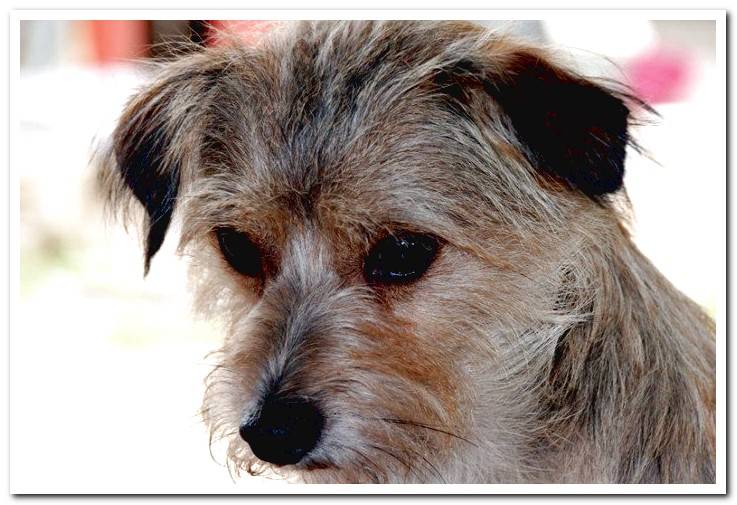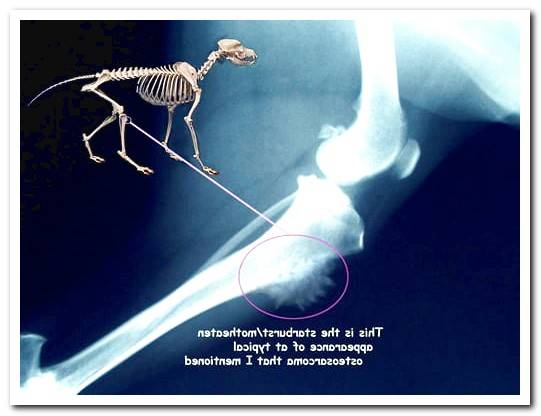
There are many types of cancer in dogs that are easily distinguishable, others, however, are hidden at first sight and certain veterinary tests are necessary to detect them. We will explain what are the most common types of cancer in dogs and what are their characteristics.
Remember that even if your dog has the same symptoms that you can read in this article, it is totally necessary to carry out different veterinary tests to verify that it is cancer.
Index of contents
- 1 Skin cancer
- 2 Bone Cancer
- 3 Breast cancer
- 4 Examples of tumor presentations
- 4.1 Cutaneous papilloma
- 4.2 Lipoma
- 4.3 Histiocytoma
- 4.4 Sebaceous adenoma
- 4.5 Mastocytoma
- 4.6 Squamous cell carcinoma
- 4.7 Melanoma
- 4.8 Lymphoma
- 4.9 Osteosarcoma
- 4.10 Chondrosarcoma
- 4.11 Testicular tumor
- 4.12 Transmissible venereal tumor
- 4.13 Vaginal tumor
- 4.14 Ovarian tumor
- 4.15 Breast tumor
- 4.16 Leukemia
Skin cancer
Skin cancer is one of the most common in dogs, because they spend long hours of exposure under the negative effects of the sun. We all know that dogs love to lie down, relax and sleep in the sun, feeling its warmth. It is also because thanks to the sun they can collect vitamin A in their hair, which they later absorb through licks (they do not absorb it through the skin).
The sun is getting stronger and more harmful on our planet, so it is advisable to use sunscreen before taking it. Puppies do not use any type of sun protection and although their skin is almost completely protected by their hair, sometimes this not enough to avoid long-term and harmful exposure.
Skin irritation, hair loss, skin rashes, or small bumps may be the first symptoms of skin cancer. If we detect any of these cancer symptoms We should immediately consult a veterinaryn and carry out the necessary tests.

Bone Cancer
Unfortunately this type of cancer is invisible to our eyes, there is nothing that we can superficially detect in the dog that does not indicate that it may suffer from bone cancer.
This makes it very difficult to detect it in time, when it starts, so normally when it is detected it is too late. It is also a very aggressive type of cancer, which evolves very quickly and ends the life of a dog in a few months, even if it is in cancer treatment.
The dogs of greater size are those that have more possibilities of suffering it, there are many studies that confirm that this type of cancer is mainly due to a poor quality diet. Poor quality feed or balanced for dogs sometimes contains excess fluorine, which mainly causes bone cancer.

Breast cancer
It is undoubtedly the most widespread type of cancer among bitches, which can avoid suffering it with a simple complete sterilization when they are young. If we do not think that our dog has pups, it is best to sterilize it in a veterinary cynical crib.
In this way, we will be able to prevent in more than eighty percent of the possibilities of breast cancer. For a dog to suffer from breast cancer, it does not necessarily have to give birth, but the real causes of the origin are unknown.
Among the different types of cancer, breast cancer is very easy to detect since it presents lumps or wounds in our dog’s breasts. If this happens, we must go to a veterinaryn to carry out tests and give us a definitive diagnosis.
- Complete Information on Breast Cancer in Bitches
Examples of tumor presentations
Next we are going to review the most common presentation of the tumors that most frequently suffer from dogs. It does not mean that whenever we find, for example, a wart, it is a malignant cancer. But we should consult with the vet.
Cutaneous papilloma
The appearance is that of a wart that appears on the skin of any part of the body, the pads or behind the nails. More frequent in elderly dogs. They are benign and it is not even always necessary to remove them.
- Information about warts in dogs
Lipoma
Rounded shape and soft and soft consistency. It usually grows slowly. It is more common in overweight females. Typically they are benign. They are removed if they interfere with the dog’s quality of life.
Histiocytoma
Its appearance is reminiscent of a button. A small, hairless elevation forms that can appear anywhere on the body. It usually grows rapidly. It affects more young dogs, between one and three years old. Many disappear spontaneously.
Sebaceous adenoma
It forms in the sebaceous glands. It is usual that we see it on the eyelids or the extremities. It can be single or multiple. It is a soft, lobulated lump on a kind of stem.
The surface will not have hair and can also ulcerate. Above all, it affects elderly dogs. It is most common in specimens of the Boston terrier and Cocker spaniel about 9-10 years old. They are mostly benign.
Mastocytoma
Although its appearance is highly variable, the typical one is a multinodular, reddened, hairless and ulcerated lump. They are frequent tumors. They affect brachycephalic breeds more from the age of nine.
They appear on the trunk, perineum, lower abdomen, foreskin and hind legs. Another symptom of mastocytoma is gastroduodenal ulcers. There are as many malignant as benign cases.
Squamous cell carcinoma
There are a variety of appearances. It can be seen as a hard, flat, grayish ulcer, a stiff red area, or a cauliflower-like lump. With or without hair loss. As they are due to ultraviolet radiation, it appears in areas with little pigmentation.
Melanoma
It produces a brown or black nodule on heavily pigmented areas of the skin such as eyelids, lips or extremities. They are seen more in breeds such as the Scottish terrier, the Boston terrier or the Cocker spaniel. Especially those of the mouth or nails are usually malignant.
Lymphoma
Enlarged lymph nodes are found in the groin, armpit, neck, or chest. The dog stops ea
ting, loses weight and is turned off. The liver and spleen are also enlarged.
When it affects the chest, a pleural effusion can occur, causing respiratory complications. If the damage is to the skin, nodules or pruritic areas appear. In cases of lymphoma at the intestinal level, the dog suffers vomiting and diarrhea. Also, there is anemia and calcium is elevated.
Osteosarcoma
It can manifest as a limp that is followed by inflammation of the leg or palpation of a mass in the area. In addition to the front and rear legs, it is also located in the ribs and jaw.
It is more common from the age of eight and in giant or large breeds such as the Saint Bernard, the Newfoundland, the Boxer, the Irish Setter or the Great Dane. It is usually very aggressive and metastasize to the lungs.
Chondrosarcoma
It usually affects the ribs, nose and pelvis. Large, hard swelling can be detected. More common in dogs over six years old, unfortunately, it tends to be malignant and reproduce in the lungs.
Testicular tumor
They are more common in dogs with retained testicles in the groin or abdominal cavity. You would notice a mass in that area. If the testicle is not retained, it will appear larger than the healthy one. It will be hardened and will show an irregular and nodular surface.
Also, some of these tumors produce estrogens. This causes the dog to present characteristics characteristic of females with an enlargement of the mammary glands, in addition to symmetrical bilateral alopecia or a hanging foreskin. The average age of onset is ten years, but can be detected from six.
Transmissible venereal tumor
They can be solitary or multiple, with cauliflower or nodule shape, single or multiple, with stem. Sometimes they ulcerate. They are located in the vagina and vulva of females and on the penis of males. In both they can be detected in the perineum, face, mouth, nose or legs.
Vaginal tumor
Warning signs are vaginal discharge or bleeding, protrusion of a mass by the vulva, increased frequency of urination, or recurrent licking of the area. Those of greater size manage to deform the region of the perineum and, if applicable, would obstruct the birth canal. Most common in whole bitches of about ten years.
Ovarian tumor
They do not usually produce symptoms, but sometimes it is possible to appreciate swelling in the abdominal cavity, ascites, hyperestrogenism, abnormal jealousy, enlargement of the vulva or a greasier skin and hair.
Breast tumor
It is perceived as a lump, generally in the larger breasts. It can be more or less large and have defined or undefined edges. The skin sometimes ulcerates and bleeds. They are very common in unsterilized bitches from the age of six. They can be malignant and spread very quickly.
Leukemia
The symptoms are nonspecific, which makes diagnosis difficult. Fever, thinning, anorexia, anemia, or pale mucosa occurs. Its appearance is more common in middle-aged dogs.
